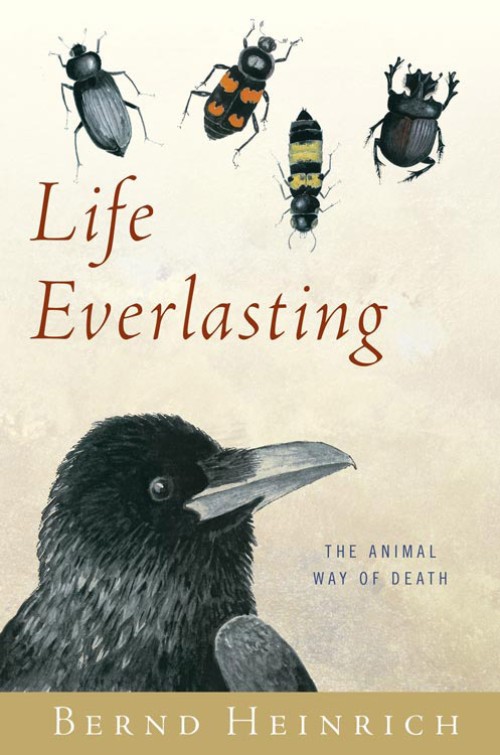by Bernd Heinrich
Houghton Mifflin Harcourt, 2012
On a December morning, a decapitated buck, one leg hacked off, showed up in a gully near my home. Once I deciphered what was bleeding in the tawny leaves, I begged my neighbor with a backhoe to do something. “We don’t have to,” he smiled. I wondered. By day three, only a tuft of pelt remained. Who convened to consume the buck? I longed to know more about the gift economy of death. Then I received Bernd Heinrich’s Life Everlasting.
Professor Heinrich’s sixteenth book is a primer and meditation on the uses of mortality in the natural world, inspired by a letter from a terminally ill friend requesting a green burial on the author’s land in Maine. Rejecting the waste, pollution, and isolation of western funeral practices, the friend writes, “Death is … also a wild celebration of renewal, with our substance hosting the party.”
In 194 pages, Heinrich transports the reader to the movable feast of hunter, scavenger, and prey: intricate dances of interdependence linking bacterium, virus, fungus, weed, maple, beetle, mouse, botfly, raven, salmon, elephant, and whale. Heinrich learned about the hunger dance as a refugee child after World War II. His family survived by trawling the German forest for acorns, mushrooms, roots, berries, rodents, or the larger windfalls luck would offer. When he and his sister found a dead elk, their parents, like cats or ravens, concealed it with brush. Only the proximity of civilization keeps scavengers from mtheir prize. Reflecting on his youth, he writes, “I think I was then a dyed-in-the-wool predator.”
Heinrich’s evenhanded empathy for hunter, scavenger, and prey enriches his scientific inquiry. For each tale told, he assures us, many more could be spun. Through his eyes, the reader witnesses the sky dance of ravens, the noble undertaking of vultures, the suicidal spawning rites of salmon, the drowning death of whales, the metamorphosis of the sphinx moth, and human rites that plan for transformation.
Heinrich’s tone is casual, lyrical, and often jovial. In forest or jungle, his gusto for any carcass and its guests is contagious. “The fresh mouse… I put out this morning is no longer visible,” he effuses in his journal. The mouse’s disappearance is the undertaking of burial beetles. They lie on their backs together to “walk” the dead mouse to a burial destination, spray it with a personal antibiotic to retard spoilage, lay eggs nearby, and harvest the carcass for their larvae, which crawl over to the carcass upon hatching. So it goes: with death comes deep sustenance from the salmon, the elephant, the giant tortoise, or the tiny grub.
Always alert to teachable moments, Heinrich invites students to his place in Maine, where a road-kill doe putrefies in the meadowsweet. The revelers, with their elderberry wine and maudlin songs, keep “the big guys” at bay, while the botflies make a meal of the deer. A fitting wake, he thinks. “I might be envious, were it my turn to return to the cycle of life.”
Heinrich illustrates the text. His rendering of mated ravens, “in portrait and while preening each other,” is soft and tender, as if to say, until you draw them, you don’t know them. The reader marvels at his stamina: the details of his data and the global significance of his insight. Detective, advocate, philosopher, who is he? How did one man figure all this out? Google “Bernd Heinrich.” Deadpan Wikipedia mentions that the prolific professor emeritus, now 72, can run a hundred miles in record time. Like a persistence hunter of the Kalahari Desert, the author may exhaust an antelope, yet he never leaves the reader in the dust.


